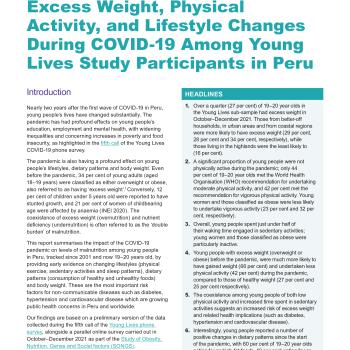
Nearly two years after the first wave of COVID-19 in Peru, young people’s lives have changed substantially. Alongside effects on young people’s education, employment and mental health, the pandemic is also having a profound effect on young people’s lifestyles, dietary patterns and body weight.
Even before the pandemic, 34 per cent of young adults (aged 18–19 years) were classified as either overweight or obese, also referred to as having ‘excess weight’.1 Conversely, 12 per cent of children under 5 years old were reported to have stunted growth, and 21 per cent of women of childbearing age were affected by anaemia (INEI 2020). The coexistence of excess weight (overnutrition) and nutrient deficiency (undernutrition) is often referred to as the ‘double burden’ of malnutrition.
This report summarises the impact of the COVID-19 pandemic on levels of malnutrition among young people in Peru, tracked since 2001 and now 19–20 years old, by providing early evidence on changing lifestyles (physical exercise, sedentary activities and sleep patterns), dietary patterns (consumption of healthy and unhealthy foods) and body weight. These are the most important risk factors for non-communicable diseases such as diabetes, hypertension and cardiovascular disease which are growing public health concerns in Peru and worldwide.

Nearly two years after the first wave of COVID-19 in Peru, young people’s lives have changed substantially. Alongside effects on young people’s education, employment and mental health, the pandemic is also having a profound effect on young people’s lifestyles, dietary patterns and body weight.
Even before the pandemic, 34 per cent of young adults (aged 18–19 years) were classified as either overweight or obese, also referred to as having ‘excess weight’.1 Conversely, 12 per cent of children under 5 years old were reported to have stunted growth, and 21 per cent of women of childbearing age were affected by anaemia (INEI 2020). The coexistence of excess weight (overnutrition) and nutrient deficiency (undernutrition) is often referred to as the ‘double burden’ of malnutrition.
This report summarises the impact of the COVID-19 pandemic on levels of malnutrition among young people in Peru, tracked since 2001 and now 19–20 years old, by providing early evidence on changing lifestyles (physical exercise, sedentary activities and sleep patterns), dietary patterns (consumption of healthy and unhealthy foods) and body weight. These are the most important risk factors for non-communicable diseases such as diabetes, hypertension and cardiovascular disease which are growing public health concerns in Peru and worldwide.

